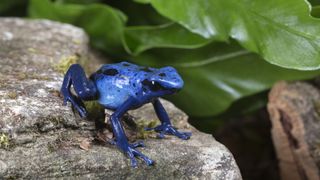 |
| In poison dart frogs, bright blue colors broadcast a warning to predators that the animal is toxic. (Image credit: Lillian King/Getty Images) |
When you look up at the blue sky overhead or gaze across the seemingly endless expanse of a blue ocean, you might think that the color blue is common in nature. But among all the hues found in rocks, plants and flowers, or in the fur, feathers, scales and skin of animals, blue is surprisingly scarce. But why is the color blue so rare? The answer stems from the chemistry and physics of how colors are produced — and how we see them.
We're able to see color because each of our eyes contains between 6 million and 7 million light-sensitive cells called cones. There are three different types of cones in the eye of a person with normal color vision, and each cone type is most sensitive to a particular wavelength of light: red, green or blue. Information from millions of cones reaches our brains as electrical signals that communicate all the types of light reflected by what we see, which is then interpreted as different shades of color.
When we look at a colorful object, such as a sparkling sapphire or a vibrant hydrangea bloom, "the object is absorbing some of the white light that falls onto it; because it's absorbing some of the light, the rest of the light that's reflected has a color," science writer Kai Kupferschmidt, author of "Blue: In Search of Nature's Rarest Color" (The Experiment, 2021), told Live Science.
"When you see a blue flower — for instance, a cornflower — you see the cornflower as blue because it absorbs the red part of the spectrum," Kupferschmidt said. Or to put it another way, the flower appears blue because that color is the part of the spectrum that the blossom rejected, Kupferschmidt wrote in his book, which explores the science and nature of this popular hue. READ MORE